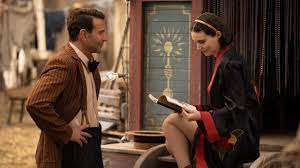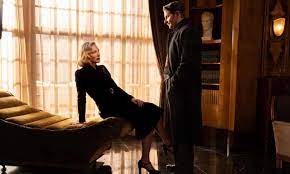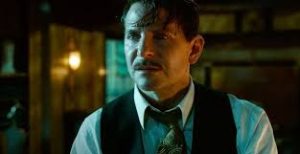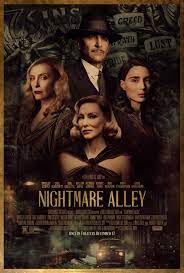Warning! Mild spoilers
I was a little late to the party, but I’m glad I finally showed up while it was still going on. It’s a bummer that Nightmare Alley is doing so poorly at the box office because this is an excellent film that is cinematic enough that it ought to be seen in a theater in order to fully appreciate everything that’s going on.
Nightmare Alley is a movie fan’s movie. It has a lot of the motifs of classic Film-Noir, and if you have followed this blog in the past, you know that I have some definite thoughts on that style of filmmaking, and many of my favorite films are Noir. There are also elements of Nightmare Alley that reminded me a lot of Stanley Kubrick. Regular followers of this blog will also note that Kubrick is my favorite director and Guillermo del Toro channeled his inner-Kubrick when staging and pacing this film.
I’m going to get my critique out of the way. The only issue I had with the film was that some aspects of the storyline were a tad on the news and the twist at the end was predictable, but the predictability did nothing to reduce the tension in the overall story.
In fact, del Toro and co-screenwriter Kim Morgan did something strikingly similar to what Billy Wilder and Raymond Chandler did in what might be the greatest ever Film Noir, Double Indemnity. One of the first things to happen in that film is they give away the ending when Walter Neff in the recording he’s making for his boss Barton Keys, says, “I killed him for money, and for a woman. And I didn’t get the money, and I didn’t get the woman.” We’re less than five minutes into the movie, and they tell us essentially what the main character is going to want and that he’s not going to get it.
Del Toro and Morgan did a similar thing in Nightmare Alley, but this was around halfway through the film. The main character, Stanton Carlisle (Bradley Cooper) meets up with some old friends from his days at the circus, including the tarot card reader Zeena (Toni Collette), and she tells him not to try and pull the scam he’s working on. The tarot cards show that he’s not only going to fail, but it will be his downfall. We are basically told at the midpoint of the film that not only is Stanton not going to accomplish his goal, but the attempt will ruin him. Yet we are compelled to keep watching, mostly because del Toro and Morgan did an excellent job of getting Stanton tantalizingly close before the rug is pulled out from under him.

Another interesting thing about how this story was constructed was the actual dramatic structure. Normally screenplays are written in three (or four) act-structure with the direction of the story changing every 30 minutes or so. Like Stanley Kubrick did in Full Metal Jacket, del Toro gave us a 2-Act structure in which the hero, or anti-hero, in this case, goes through a sort of basic training in the first act, and then plies his trade in the second act.
We spend the first forty-five minutes of the story watching Stanton learn from Zeena and her husband Pete (David Stathairn), as well as circus boss Clem Hoatley (Willem Dafoe), the art of the con, and how to use the clues people unknowingly give you to tell them things about themselves that make them believe you’re psychic. When he’s able to use his technique to fool the local sheriff, he knows he’s ready to leave the circus for bigger and better things. He has been trying to convince circus performer Molly Cahill (Rooney Mara) of the same thing, and she’s finally convinced. Having fallen in love with each other, they climb in a truck and are off to the big city.
The second act begins with us having moved ahead in time two years. Stanton has grown a pencil-thin mustache. Gone are the worn-down clothes he wore at the circus, and they’ve been replaced by a debonair tuxedo. Molly has also changed. Her hair is stylish and her evening gown is elegant. They perform their show in front of a riveted audience, but there is a skeptic among them. Dr. Lilith Ritter (Cate Blanchett) is a local psychiatrist and she thinks she sees right through Stanton’s tricks. That is until Stanton goes the extra mile, and without help from Molly is able to deduce that Lilith carries a small handgun in her purse. Judge Kimball (Peter MacNeill) is so impressed that he’s willing to pay Stanton triple his current rate to put him in contact with his deceased son.

From there, the larger scam that will ultimately doom Stanton is put in motion. Molly tries to stop him multiple times, but Stanton falls into the trap laid for him by this film’s femme fatale in Lilith. Stanton is the stereotypical Film-Noir anti-hero. We learn right away that he is not a good man. Most of the first act is spent confirming how dishonest he is and the extremes that he’s willing to go to in order to get what he wants. He is constantly warned throughout the film not to take the scams too far, but he is a flawed character and those flaws of arrogance and hubris ultimately prove to be his undoing.

Even though this film doesn’t follow a traditional Hero’s Journey, there are still plenty of archetypal elements involved, particularly with the characters. The character development in Nightmare Alley is nothing short of superb. Pete serves as a Mentor to Stanton in the first act, and Lilith serves that role in act II, however, she also reveals herself to be a shapeshifter and a shadow by the end. There are several other tricksters and threshold guardians spread throughout the story.
The two-act structure also does interesting things to the pacing of the story. The pacing of this film is deliberate. Some may call it slow, and that could be why it’s struggling at the box office. This isn’t a Marvel movie with action sequences every ten minutes. This is a deliberate and methodical story that you have to pay attention to from start to finish. This story doesn’t follow the usual formula and it is largely character-driven. If you’re looking for an action movie, Nightmare Alley probably isn’t for you. But if you’re looking for a well-crafted film that’s filled with tension that slowly builds to a crescendo, this is a film you should check out.

Even though the story itself is somewhat on the nose and predictable, the character development makes up for that and helps keep the story interesting and tense. What’s even more amazing is how few of these characters are actually likable, and we can’t take our eyes off this film. These characters are taking us on a journey we know we shouldn’t be going on, but we can’t help but follow them down the dark path they traverse. This is an exceptional film that any cinephile should rush to see.
